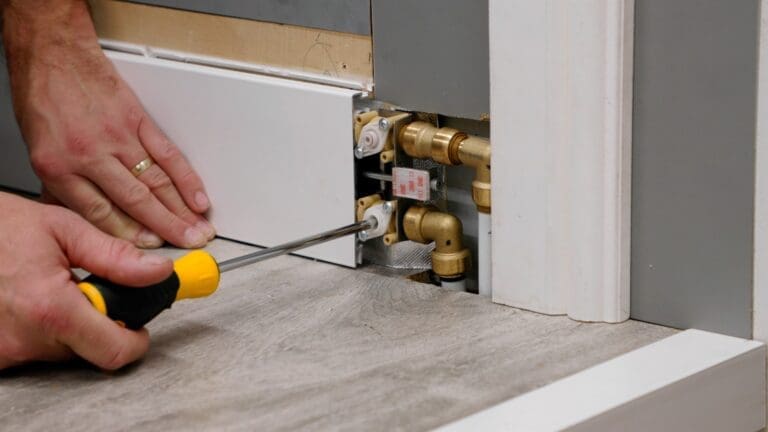
It prompted a variety of technical questions, which have been answered in a more detail here by DiscreteHeat’s sales and marketing director, Ethan Wadsworth.
Is ThermaSkirt suitable for older properties?
Yes – around 70% of the installations we’ve done so far have been retrofitted into existing properties. We are energy agnostic, so whether there’s already a heat pump or a gas boiler, ThermaSkirt will work with it.
If the home has a boiler, we have the option to oversize the ThermaSkirt. If we take out a 2kW radiator, we’ll install a larger ThermaSkirt system so the boiler can be turned down.
For example, when I moved into this 1970s house, there were radiators in every room and the boiler was running at 75°C. Now I have a ThermaSkirt system and the boiler is running at 55°C. My gas consumption has reduced by nearly 20%, because the boiler is constantly condensing.
It’s not just necessarily about working well with heat pumps, it’s actually about maximising the efficiency of the existing property. With ThermaSkirt, just the same as underfloor heating, even in an older property, you aren’t heating up the air, you’re heating up the fabric of the building. Once you’ve built up the temperature, it’s a lot more stable, even in older properties
How does ThermaSkirt heat the room? How does the air flow?
The easiest way to explain how ThermaSkirt works is first to explain how a radiator works.
There are three ways that heat energy can be transferred. There’s conduction, where heat is transferred through contact. Then there’s radiation, which is the infrared rays that come off anything that’s warmer than its environment. Finally, there’s convection, which is basically both conducted and radiated heat that’s transferred onto air molecules. The air molecules stratify: the cold dense air falls and the hot less dense air rises, so radiators create a convection current.
Even though they are called radiators, they are actually convectors. ThermaSkirt is actually a radiator in its truest sense: it’s an infrared heater. Hot water in the pipe heats up the aluminium profile and the aluminium radiates heat into the room. Inevitably, some air movement will be created, but the main heat is radiant heat, so no air flow is required. ThermaSkirt is more akin to underfloor heating in that respect, because you don’t get air flow across underfloor heating either.
There is a common misconception about how heating works. It doesn’t require any air flow. It’s offsetting the heat losses of the building, not trying to move hot air around. With older properties you can insulate, but it’s quite hard to make them airtight, so it is much more efficient to heat up the fabric of the building, either with ThermaSkirt or underfloor heating, and then the temperature will remain more stable.
How many kW of heat is generated? Is it powerful enough to heat the room?
With a boiler you can get up to around 180W per metre of ThermaSkirt. Heat pumps run at a lower temperature, around a maximum of 50°C, so you can get around 100W per metre. Either way, it’s quite a high heat output and very effective.
For example, a 4m by 4m room has about 15m of available skirting area, taking out a metre for the doorway, giving you around 2.8kW in 16 square metres. Or, to put it another way, it’s 170W per square metre.
How has the design changed over the years since the product was first launched?
Fundamentally, the way the product works hasn’t changed at all, because that’s just physics, and those laws rarely, if ever, change. The changes we’ve made have mainly been around ease of installation, aesthetics and durability. Back in 2010, where the corners met there were plastic cover plates and plastic trims. Now we use powder coated stainless steel, which looks great and is very durable. We used to use an extruded bracket, which we have changed to an injection moulded design, creating an easier and quicker installation.
Back in the day, you really needed to take your time with the installation, and we even stressed that during our training sessions. Now, the improvements have made installation a piece of cake, and even a semi-capable DIY-er can make a really good job of installing the product. Compared to plumbing a complete house with copper pipe, heating engineers say it’s a complete doddle.
How easy is it to install? Do I need to change the whole house?
The video on Instagram that went viral is literally a step-by-step for how to change a radiator for ThermaSkirt. It shows us taking the radiator off the wall, removing the skirting boards and then using the existing radiator pipe work to connect into the ThermaSkirt.
There are a lot of people who would love to have underfloor heating, retrofitting it would be totally impractical and a huge amount of work – it’s a ‘move out of your house while the work’s done’ type of job! Whereas with ThermaSkirt, you can move all the furniture to the middle of the room and work on the existing pipe work. Very few plumbing alterations are usually required – it’s just a straight swap.
You can also do it on a ‘room-by-room’ basis. It’s a common misconception that you have to do your whole house, that you have to have all radiators or all ThermaSkirt. If there’s one room in particular where you’d like to get rid of the radiators, you can just install ThermaSkirt in that one room.
And when heating engineers are retrofitting a heat pump, and find in their heat loss calculations that some of the radiators are undersized, they can either replace radiators in those rooms with ThermaSkirt or they can leave the radiators in place and use ThermaSkirt to make up the shortfall in total heat output.
For homes with a gas boiler, we want it to run as low and efficiently as possible, so we size it to the heat losses of the room. This means that if the required heat load could be achieved by installing ThermaSkirt on two walls we can match the other walls with dummy skirting.
There’s a great deal of flexibility on how you specify and install the system.
Want to join ThermaSkirt’s registered installer base?
DiscreteHeat offers a series of online training modules for installers who want to become registered ThermaSkirt installers. There are three modules to complete, and each is broken down into bite-sized chunks of easily digestible information.
Once all three modules have been completed, installers are eligible to become a Registered Installer, and start using the ThermaSkirt trade-only online portal and all its benefits. They will also receive priority technical support by phone or WhatsApp.
The next level is Accredited Installer. To qualify, installers can attend a training and assessment day, either at the DiscreteHeat training centre in Manchester or at partner training facilities across the UK.
On successful completion, their details will be added to the ‘Find an Installer’ map on the DiscreteHeat website, so that potential customers – homeowners, specifiers and contractors – can find them.
When they’ve completed 10 ThermaSkirt installations, they become a Professional Installer and will receive priority leads in their area and exclusive marketing support from the in-house team to boost their business.
Image credit: DiscreteHeat



